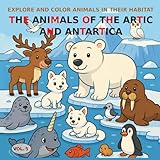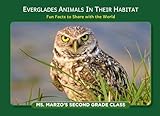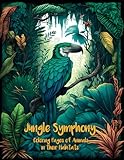The Best animal in their habitat of 2022 – Reviewed and Top Rated
After hours researching and comparing all models on the market, we find out the Best animal in their habitat of 2022. Check our ranking below.
2,193 Reviews Scanned
- LEARN ABOUT ANIMALS: These interactive magnet boards will help young ones make observations about plants and animals, and compare the diversity of life in different habitats
- LEARN ABOUT HABITATS: Young learners will love to learn where their favorite animals live through a variety of different habitat boards
- IMPROVE SORTING SKILLS: Students will identify and sort 8 native species per biome board, which include ocean, grassland, pond, rainforest, polar, and desert biomes
- GREAT ADDITION TO ENVIRONMENTAL STUDIES CURRICULUM: Students will love to play with these magnetic puzzle boards to learn about animals and their environments.
- SET INCLUDES: 6 sturdy, laminated magnetic boards measuring 12 inches x 9 inches with 48 thick, colorful magnetic animals to sort
- Galko, Francine (Author)
- English (Publication Language)
- 32 Pages - 10/10/2002 (Publication Date) - Heinemann/Raintree (Publisher)
- Azar, Alak (Author)
- English (Publication Language)
- 34 Pages - 06/09/2025 (Publication Date) - Independently published (Publisher)
- Second Grade Class, Ms. Marzo's (Author)
- English (Publication Language)
- 34 Pages - 10/06/2024 (Publication Date) - Author League (Publisher)
- Hansen, Saga (Author)
- English (Publication Language)
- 92 Pages - 06/05/2023 (Publication Date) - Independently published (Publisher)
- MATCH ANIMALS TO THEIR HABITAT: From the ocean, savanna, woodland and more - put the animals in their correct home.
- ANIMAL ARTWORK: Each tile features an illustration of an animal, the flip-side has the animal's name in 4 different languages.
- MULTI-LANGUAGE: Instructions translated in Spanish, French and German.
- SUSTAINABLY SOURCED: Made with recycled board and printed on FSC-certified paper using vegetable-based inks.
- crayons, happy (Author)
- English (Publication Language)
- 122 Pages - 06/12/2021 (Publication Date) - happy crayons (Publisher)
- Pancakes, Those Thin (Author)
- English (Publication Language)
- 70 Pages - 12/01/2023 (Publication Date) - Independently published (Publisher)
- Pancakes, Those Thin (Author)
- English (Publication Language)
- 66 Pages - 04/13/2024 (Publication Date) - Independently published (Publisher)
- MARINE BIOLOGY GAME - Learn about underwater creatures and their habitats in this nature card game! Players use aquatic animals such as sea turtles, sharks, and clownfish in a grid formation in this ecosystem building game; Earn points by aligning ocean life with the habitats and food sources where they most flourish
- GREAT BARRIER REEF - Based on the animals found in the real Great Barrier Reef, players pick and pass eleven different card types, arranging them in a grid to form their unique ecosystem; Cards are categorized as predators, prey, and producers; Diversify your food web to maximize bonus points
- GENIUS GAMES - Ecosystem: Coral Reef is the sequel to our top rated family board game, Ecosystem; Our science games for kids combine gameplay that’s both accessible to children and strategic for adults; Whether it’s for the classroom or family game night, our catalog of educational board games is perfect for encouraging critical thinking skills and learning while having fun!
- LEARN SCIENCE - In this nature board game, oceanic life aid one another in cycles that are true to our world’s ecological habitats; It intuitively teaches players about the necessary balance of natural order via the food web system; players want a healthy mix of predators, prey, and producers in their ecosystem to score the most points
- English (Publication Language)
Last update on 2025-08-20 / Affiliate links / Images from Amazon Product Advertising API
How Do You Buy The Best animal in their habitat?
Do you get stressed out thinking about shopping for a great animal in their habitat? Do doubts keep creeping into your mind? We understand, because we’ve already gone through the whole process of researching animal in their habitat, which is why we have assembled a comprehensive list of the greatest animal in their habitat available in the current market. We’ve also come up with a list of questions that you probably have yourself.
We’ve done the best we can with our thoughts and recommendations, but it’s still crucial that you do thorough research on your own for animal in their habitat that you consider buying. Your questions might include the following:
- Is it worth buying an animal in their habitat?
- What benefits are there with buying an animal in their habitat?
- What factors deserve consideration when shopping for an effective animal in their habitat?
- Why is it crucial to invest in any animal in their habitat, much less the best one?
- Which animal in their habitat are good in the current market?
- Where can you find information like this about animal in their habitat?
We’re convinced that you likely have far more questions than just these regarding animal in their habitat, and the only real way to satisfy your need for knowledge is to get information from as many reputable online sources as you possibly can.
Potential sources can include buying guides for animal in their habitat, rating websites, word-of-mouth testimonials, online forums, and product reviews. Thorough and mindful research is crucial to making sure you get your hands on the best-possible animal in their habitat. Make sure that you are only using trustworthy and credible websites and sources.
We provide an animal in their habitat buying guide, and the information is totally objective and authentic. We employ both AI and big data in proofreading the collected information. How did we create this buying guide? We did it using a custom-created selection of algorithms that lets us manifest a top-10 list of the best available animal in their habitat currently available on the market.
This technology we use to assemble our list depends on a variety of factors, including but not limited to the following:
- Brand Value: Every brand of animal in their habitat has a value all its own. Most brands offer some sort of unique selling proposition that’s supposed to bring something different to the table than their competitors.
- Features: What bells and whistles matter for an animal in their habitat?
- Specifications: How powerful they are can be measured.
- Product Value: This simply is how much bang for the buck you get from your animal in their habitat.
- Customer Ratings: Number ratings grade animal in their habitat objectively.
- Customer Reviews: Closely related to ratings, these paragraphs give you first-hand and detailed information from real-world users about their animal in their habitat.
- Product Quality: You don’t always get what you pay for with an animal in their habitat, sometimes less, and sometimes more.
- Product Reliability: How sturdy and durable an animal in their habitat is should be an indication of how long it will work out for you.
We always remember that maintaining animal in their habitat information to stay current is a top priority, which is why we are constantly updating our websites. Learn more about us using online sources.
If you think that anything we present here regarding animal in their habitat is irrelevant, incorrect, misleading, or erroneous, then please let us know promptly! We’re here for you all the time. Contact us here. Or You can read more about us to see our vision.
FAQ:
Q: How are animals adapted to live in their habitat?
A: Generally, organisms adapt to their habitat by the following means: Changes in body. Many plants and animals develop special body parts that help them to survive in their habitat. … Changes in behaviour. Many organisms show specialized behaviour to survive in their habitat. … Changes in location: Certain animals (e.g., some birds and fish) move from one region to another in response to climatic changes. …
Q: How do animals and plants survive in their habitat?
A: The animals and plants that live in a particular habitat have adaptations that allow them to survive there. For example, spider monkeys-which live in the trees of some tropical forests-have flexible tails that allow them to grasp and balance along branches. And a cactus that grows in the desert has spines that help collect and retain moisture.
Q: What makes a habitat suitable for an animal?
A: water, food, shelter, air, a safe place to raise young
Q: How are animals losing their habitat?
A: Reptiles and Amphibians. Deforestation provides the major cause of habitat loss for most rainforest reptiles, while many species of amphibians are also losing their homes due to oil drilling and mining practices that contaminate ponds, rivers and streams, forcing them to find new sources of water for their semiaquatic lifestyles.









